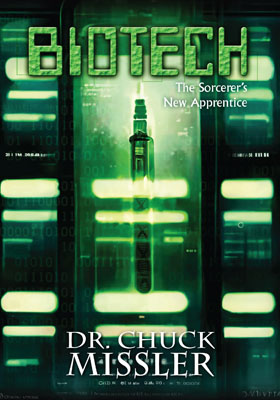In our series of articles on the current Biotech Revolution, certainly the most controversial area is that of "cloning," the common vernacular for nuclear transplant techniques. While there continue to be many serious hurdles yet to be overcome, after over 60 years of research on animals such as sea urchins, frogs and mice, the cloning of commercially relevant mammals finally seems feasible.
A Clone in Sheep's Clothing
In 1997, a rather ordinary-looking lamb named Dolly made the front pages around the world because she was produced by cloning. Ian Wilmut and his colleagues at the Roslin Institute in Edinburgh, Scotland, shattered the previous convictions among biologists and demonstrated that cells from adult mammals could be manipulated to regenerate an entire animal. In addition to creating a major stir among the scientific community, the event has raised serious moral, ethical, and legal concerns, particularly regarding the potential of cloning humans. Among other things, it would mean that women would be able to reproduce without any involvement of men.
The Nuclear Transfer Technique
Wilmut and his coworkers accomplished their feat by transferring the nuclei from various types of sheep cells into unfertilized sheep eggs from which the natural nuclei had previously been removed by microsurgery. Once the transfer was complete, the recipient eggs contained a complete set of genes, just as they would if they had been fertilized by a sperm. The eggs were then cultured for a period of time before being implanted into a sheep that carried them to term, one of which culminated in a successful birth. The resulting lamb was, as expected, an apparent exact genetic copy, or clone, of the sheep that provided the transferred nucleus, not of that which had provided the egg. Other researchers have previously cloned animals, including mammals, by transferring nuclei from embryonic cells into such enucleated eggs.1 The key to success at the Roslin Institute seems to have been that Wilmut starved the mammary cells for five days before extracting their nuclei. This maneuver "froze" the cells in a quiescent phase of their division cycle and may have made their chromosomes more susceptible to being reprogrammed to initiate the growth of a new organism after the nuclei were transferred into the egg.
It is unclear how much practical benefit Wilmut's technique will yield in the short term: it is very labor intensive and it required 277 nuclear transfers to produce the single, viable cloned lamb. At present, cloning from embryonic cells and even old-fashioned animal breeding are still more efficient ways of producing large numbers of genetically altered animals. But even so, Wilmut's experiment provided a long-sought confirmation that adult cells do in fact contain workable versions of all the genes necessary to produce an entire organism. Moreover, the procedure will surely be refined and may become an important aid in all manner of biological and biomedical investigations. It may, for example, be used to mass-produce animals that mimic human diseases for research purposes.
As for the possible use of cloning to produce copies of humans, most ethicists' initial reaction is that such an action would be unconscionable - although in the U.S., unlike in the U.K. and many other nations, it is not explicitly illegal. And opinions may change when confronted with real-world situations. Should grieving parents be denied the opportunity to produce an identical copy of their dying baby?
Health Risk
It turns out that cloning involves serious health risks, usually resulting in death for the clones themselves and sometimes even killing the surrogate mothers pregnant with those clones. As potential experimenters expand their efforts to an ever-increasing variety of animals - cows, goats, sheep, mice, etc. - it is becoming clear that the problem is not simply beginner's bad luck: there are placental abnormalities, abnormal swelling, three to four times the normal rate of umbilical cord problems, and severe immunological deficiencies.
In large mammals such as sheep and cows, researchers are finding that about half of all clones that develop into fetuses harbor serious abnormalities, including peculiar defects in the heart, lungs, and other organs - many of them fatal before birth. Others have succumbed weeks or months after birth, dying suddenly and mysteriously after a seemingly healthy start.
The problems offer a sobering perspective on how much remains unknown about how to develop animals from a single parent. One of the deepest questions in reproductive biology is the need for DNA from both a male and a female to create a viable offspring. The cause of these abnormalities and deaths remains a mystery, but there is growing evidence that at least some are linked to a disruption of a genetic mechanism known as "imprinting."
Imprinting
Imprinting was discovered about a decade ago and appears to be nature's way of ensuring that every baby has two parents. (The only known exception is celebrated every Christmas season!) While only vaguely understood, it appears to work on the molecular level inside the sperm and eggs, labeling certain genes with genetic tags that identify the source as being from the mother or the father. The tags function as tiny molecular switches, determining whether the mother's or the father's genes will be active in various parts of the developing embryo. In order for a newly fertilized egg to develop into a normal embryo, a proper combination of mother genes and father genes must be present.
Many scientists believe that imprinting will be a major hurdle to overcome if cloning is ever to become practical. But imprinting problems do not account for all of the problems in cloning. Autopsies often reveal metabolic abnormalities, as well as immune system deficiencies.
Human Cloning Venture
Not deterred by the current obstacles, a small group of scientists is planning to begin attempts at cloning a human being in a venture called Clonaid. The company claims it has the technology and financial backing to complete the task.2 Dr. Brigitte Boisselier plans to have a baby in 18 months, which would be the "genetic twin" of a 10-month old baby girl who died following an accident. The baby's parents, a wealthy American couple, will pay $1 million to finance the first attempt. Dr. Boisselier indicated that after the first successful cloning attempt, they plan to charge a fee of $200,000 for each cloned baby.3
The company's founder, who calls himself Rael, plans to offer cloning services to homosexuals so that they can start families. Rael is the founder of the Raelian sect, which believes that humans are the result of genetic experimentation by a race of extraterrestrials. The sect claims 50,000 members in France, Canada, Japan and 80 other countries. Fifty young Raelian women have volunteered to be surrogate mothers, supplying eggs and providing womb space for embryos, according to Dr. Boisselier.
Dr. Stephen Post, biomedical ethicist at Case Western Reserve University School of Medicine, Cleveland, has pointed out that the venture violates several ethical principles. "Cloning Dolly took 277 attempts; that means there were 276 failures," Dr. Post said. In human terms that means putting both the "gestating fetus" and the surrogate mother at risk of harm as the result of multiple miscarriages.
The Ultimate Presumption
Certainly the most outrageous cloning project yet to surface would be an attempt to bring about the "Second Coming" of our Lord Jesus Christ. The intention would be to utilize the same techniques which have been pioneered at the Roslin Institute by taking an incorrupt cell from one of the many relics reputed to contain a sample of Jesus' blood that are preserved in churches throughout the world, extracting the DNA, and inserting it into an unfertilized human egg (oocyte), through nuclear transfer. The fertilized egg, now ostensibly a zygote of Jesus Christ, would be implanted into the womb of a young virginal woman who would then bring the baby to term in a second "Virgin Birth."
Despite numerous Biblical misinterpretations and the many presumptuous conjectures involved, there is an Internet website dedicated to such a venture4 (although this may well be simply a fund-raising hoax). The plans overlook the substantial research that remains to be done and consequential risks involved. Dolly the sheep was preceded by 276 failures. The ostensible availability of the requisite DNA is also a non-trivial problem. While not dissimilar from the fictional DNA embodied in the blood of the prehistoric mosquito encapsulated in amber that formed the basis of Michael Crichton's provocative novel, Jurassic Park, such a project would depend on, among other things, the legitimacy of the religious relics being relied upon for the DNA samples. This would appear to be fatally naive, although there are competent scientists who do take the Shroud of Turin very seriously.5
(There are also those, however, who would argue that they might end up with a clone of Jacques De Molay rather than the One whom they are expecting. There are those that believe the Shroud of Turin was actually that of a crusader, the last Grand Master of the Knights Templar, who was crucified by the Inquisition as a sardonic torture prior to his being burned at the stake in 1314.6)
There are also other provocative conjectures.
The Antichrist?
It is interesting that the "Clone Jesus Project" even has a schedule: "If all goes according to plan, the birth will take place on December 25, 2001, thus making Anno Domini 2001 into Anno Domini Novi 1, and all calendrical calculations will begin anew." It is noteworthy that the Coming World Leader-Satan's Messianic imitation prophesied in the Bible-"will think to change the times and the laws."7 Could these technologies have an implication for other Pretenders on the horizon?
The convolutions that current biotechnologies may hold for the future cannot help but impact our conjectures regarding the bizarre prophecies which the Bible spells out for the coming climax of human history: directable pestilences, 8 the mixing of non-seeds with the seed of men, 9 injectable microchips,10 images that speak (and enforce).11 Several prominent Bible commentators have openly conjectured that this Coming World Leader (commonly called "the Antichrist") may be an "alien" or have some kind of alien connection. Could this also involve some perversion of biotechnological manipulations?
The last time man pursued (and misapplied) knowledge to such an extent, God intervened to disrupt their designs. As the Bible says in Genesis 11:6, "...now nothing will be restrained from them, which they have imagined to do." How long will it be before His patience is once again exhausted?
Next month we will explore further some of the Biblical implications of the strange prospects emerging from the current microbiological revolution and related convergent technologies.
This article was excerpted from our newest Briefing Package, Biotech: The Sorcerer's New Apprentice.
Notes:
- Wilmut's group published such a result using sheep cells in the March 7, 1996, issue of Nature.
- Private Group Set To Launch Human Cloning Scheme," UPI, Oct. 13, 2000.
- www.clonaid.com.
- A website devoted to this project can be viewed at www.clonejesus.com.
- Ian Wilson, The Blood and the Shroud, Simon and Schuster Inc., New York, 1998.
- Christopher Knight and Robert Lomas, The Second Messiah, Element Books, Boston MA, 1997; also, The Hiram Key, Element Books, Boston MA, 1996.
- Daniel 7:25.
- Revelation 6:8; 9:3ff.
- Daniel 2:43.
- Many presume an application from Rev 13:18 (we don't).
- Revelation 13:15.







